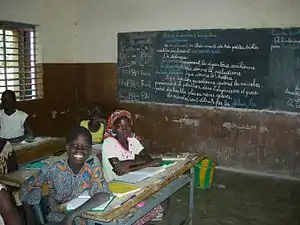| Languages of Burkina Faso | |
|---|---|
 Ethnolinguistic map of Burkina Faso | |
| Official | Mooré, Bissa, Dyula, Fula |
| Indigenous | Mande languages, Gur languages, Senufo languages, Wara–Natyoro languages, Hausa, Humburi Senni, Siamou, Tamasheq, Western Plains Dogon |
| Signed | American Sign Language Burkina Sign Language |
| Keyboard layout | |

Burkina Faso is a multilingual country. An estimated 70 languages are spoken there, of which about 66 are indigenous.[1] Mooré is spoken by about 52.5% of the population, mainly in the central region around the capital, Ouagadougou.
In the west, Mande languages are widely spoken, the most predominant being Dyula (also spelled Jula or Dioula), others including Bobo, Samo, and Marka. Peul (Fula: fulfulde), a dialect of Fulani, is spoken in the north, however it is widely spoken throughout the country as a lingua franca. Gourmantché is spoken in the east, while the Bissa language is spoken in the south.[2]
Education for the deaf in Burkina uses American Sign Language, which was introduced by the deaf American missionary Andrew Foster. The Burkina Sign Language is used in Ouagadougou.[3]
National languages
Mooré is the most widely spoken language in the country, with 48 percent of Burkinabe being speakers as of 2008 and is a de facto lingua franca.[4] Dyula and Peul are also recognized as national languages. This has caused consternation with speakers of the other languages, who have protested it as an injustice.[5]
The country's name was taken from words in two of the most widely spoken languages, with ‘Burkina’ meaning ‘man of integrity’ in Mooré and ‘Faso’ meaning ‘father’s house’ in Dyula.
Peul is the lingua franca in many parts of Burkina Faso.[6] It is widely spoken in the north and east of the country as a first language, with 8.36 percent of the population able to speak it.[2][7] Dyula is also a lingua franca and is widely used as a trading language, particularly in the west and in Bobo-Dioulasso.[2] A 2014 survey reported that 5.7% of the population speaks Dyula as their dominant language at home,[8] but the number of L2 speakers is likely much higher.
Most of the languages that are spoken belong to either the Mande or Gur branches. In rural areas of Burkina Faso, one's native language is typically used for common activities.[2] In large towns, most people are multilingual.[9] Although not recognized as a national language, Gourmanché is spoken by 5.51% of the population. Other important minority languages include Bissa, spoken by 2.85%; Bwamu, spoken by 1.91%, Dagara, spoken by 1.76%; and Samo, spoken by 1.66%.[7] Dagara is spoken in the southwestern part of Burkina Faso and borrows heavily from French and, to a lesser degree, English.[10]
Endangered languages include:
- Jalkunan [aka Dyala, Dyalanu, Jalkuna][11]
- Kalamsé [aka Kalemsé, Kalenga, Sàmòmá][12]
- Khe [aka Kheso, Bambadion-Kheso,][13]
- Khisa [aka Komono, Khi Khipa, Kumwenu][14]
- Natioro [aka Koo'ra, Natyoro, Natjoro][15]
- Pana (Burkina Faso) [aka Sama,][16]
- Pongu [aka Pongo, Pangu, Arringeu][17]
- Sininkere [aka Silinkere, Silanke,][18]
- Tiéfo [aka Foro, Tyefo, Tyeforo][19]
- Wara [aka Wára, Ouara, Ouala][20][21]
See also
References
- ↑ Lewis, M. Paul (ed.), 2009. Ethnologue: Languages of the World, Sixteenth edition. Dallas, Tex.: SIL International. (Page on "Languages of Burkina Faso.")
- 1 2 3 4 Rupley, Lawrence; Bangali, Lamissa; Diamitani, Boureima (2013). Historical Dictionary of Burkina Faso. Rowman & Littlefield. p. 123. ISBN 978-0810867703.
- ↑ Brentari, Diane (2010). Sign Languages. Cambridge University Press. p. 406. ISBN 978-1139487399.
- ↑ Kone 2010, page 9
- ↑ Kone 2010, p. 10
- ↑ "Fulfude, Moore & Dioula" (PDF). National African Language Resource Center. Indiana University. Retrieved 24 October 2016.
- 1 2 Language census form Archived 3 March 2016 at the Wayback Machine Burkina Faso Government
- ↑ "WP172: 800 languages and counting: Lessons from survey research across a linguistically diverse continent | Afrobarometer". afrobarometer.org. Retrieved 24 January 2020.
- ↑ Baker, Colin; Jones, Sylvia (1998). Encyclopedia of Bilingualism and Bilingual Education. Multilingual Matters. p. 356. ISBN 1853593621.
- ↑ Beyogle, Richard (2015). "Language contact in two border communities in Burkina Faso and Ghana. Lexical borrowings from French, English and African languages". Ph.D. Dissertation. Retrieved 24 October 2016.
- ↑ "Did you know Jalkunan is endangered?". Endangered Languages. Retrieved 17 December 2019.
- ↑ "Did you know Kalamsé is threatened?". Endangered Languages. Retrieved 17 December 2019.
- ↑ "Did you know Khe is threatened?". Endangered Languages. Retrieved 17 December 2019.
- ↑ "Did you know Khisa is threatened?". Endangered Languages. Retrieved 17 December 2019.
- ↑ "Did you know Natioro is vulnerable?". Endangered Languages. Retrieved 17 December 2019.
- ↑ "Did you know Pana (Burkina Faso) is threatened?". Endangered Languages. Retrieved 17 December 2019.
- ↑ "Did you know Pongu is vulnerable?". Endangered Languages. Retrieved 17 December 2019.
- ↑ "Did you know Sininkere is threatened?". Endangered Languages. Retrieved 17 December 2019.
- ↑ "Did you know Tiéfo is endangered?". Endangered Languages. Retrieved 17 December 2019.
- ↑ "Did you know Wara is threatened?". Endangered Languages. Retrieved 17 December 2019.
- ↑ "Endangered Languages Project - Search". www.endangeredlanguages.com. Retrieved 17 December 2019.
